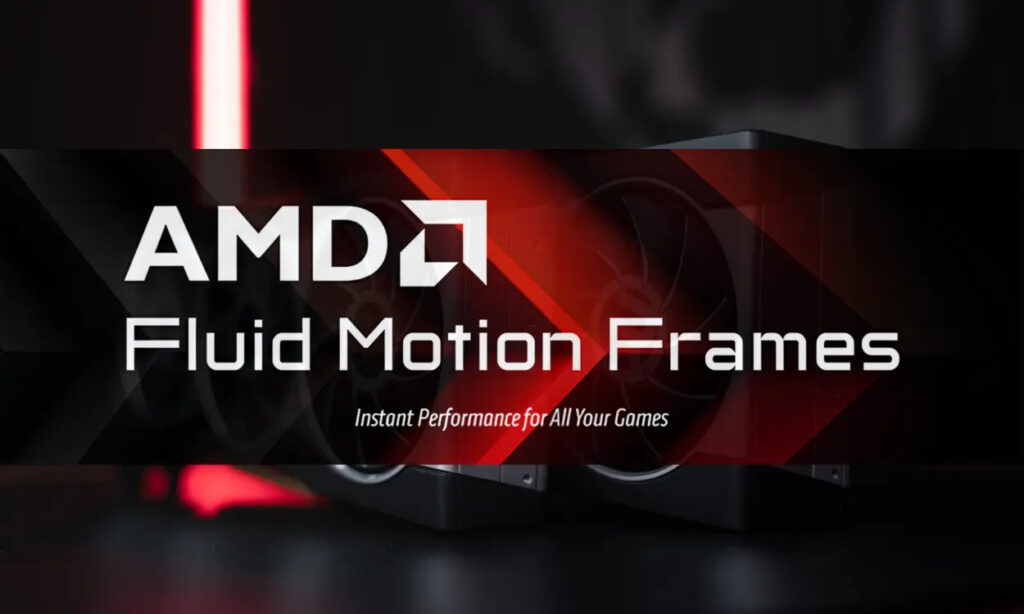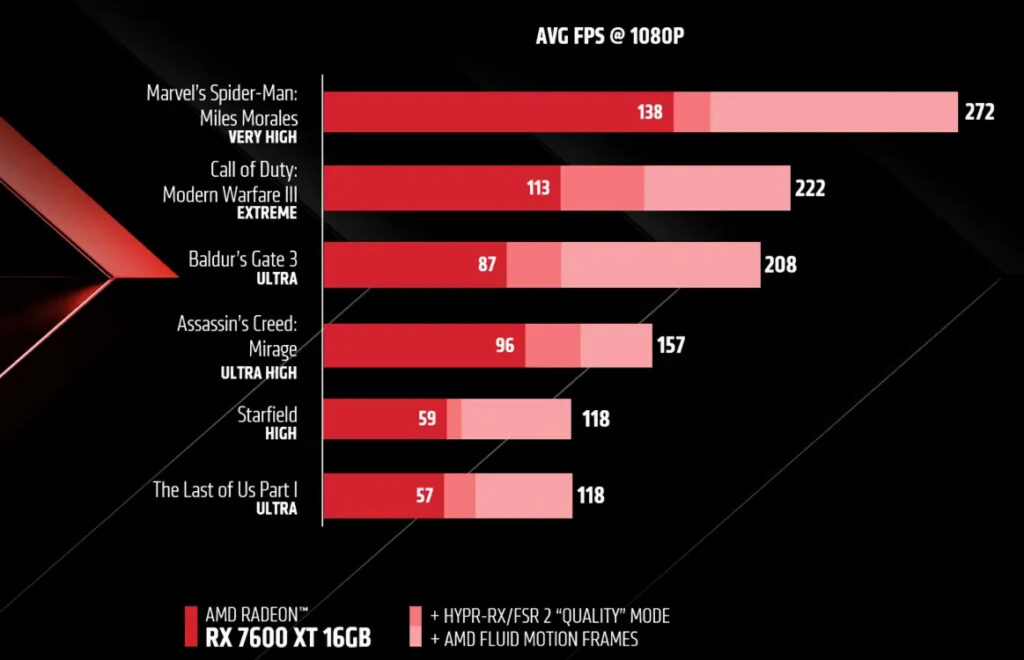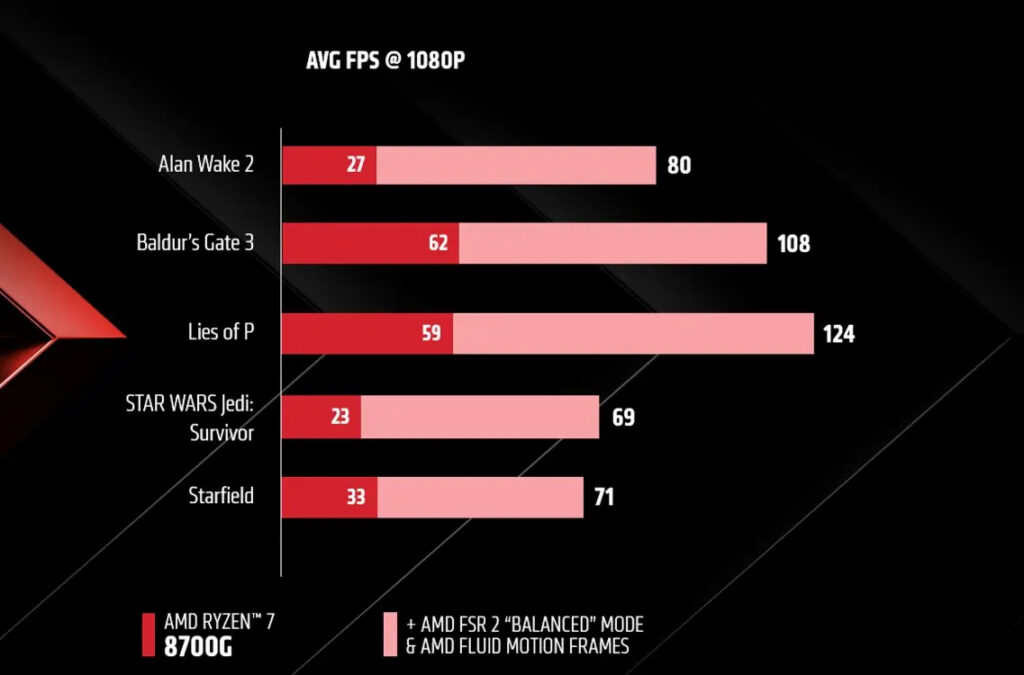
AMD has recently launched the latest Adrenalin Edition 24.1.1 drivers, introducing various new features. Notably, the update includes support for AFMF (AMD Fluid Motion Frames), an AI-driven frame generation technology designed to effectively double the frames displayed during gameplay.
While these additional frames are AI-generated and not authentic frames, AMD reports an average FPS improvement of 97%. The testing was conducted on “select titles at 1080p resolution,” with FSR Quality also enabled.
To gauge the performance boost facilitated by enabling AFMF, AMD utilized the recently released RX 7600 XT 16GB GPU. The provided gaming benchmarks demonstrate the improvement in performance attributed to this technology.

AFMF can be activated for any DX11 or DX12 game through Radeon Settings. While the impact may differ across games, the technology has proven effective, nearly doubling FPS in various tested games. AMD has reportedly incorporated feedback from gamers during the preview driver/beta stage of AFMF to enhance this AI-driven frame-boosting technology.
Before enabling AFMF, AMD provides specific recommendations. The game should be in full-screen mode, with Vsync disabled. Additionally, it’s advisable to activate Radeon Anti-Lag to minimize input latency in AFMF/FSR 3-enabled gaming experiences. AMD suggests maintaining at least 60 FPS (generated without frame generation) before enabling AFMF.
AMD emphasizes that Fluid Motion Frames (AFMF) will “provide a competitive advantage against opponents“. The blog post highlights the application of AFMF technology in competitive games like Valorant. However, it’s essential to note that frame generation technology, including AFMF, may introduce additional latency. AMD acknowledges the potential for increased latency and suggests that AFMF technology “may not offer the optimal experience for fast-paced competitive titles.”
AMD Fluid Motion Frames (AFMF): Compatible GPUs
AMD’s AFMF AI Frame Generation technology is exclusive to AMD graphics cards. If a game has native FSR 3 support, it is recommended to use FSR 3 instead of AFMF. The following AMD graphics cards support AFMF:
Radeon RX 7000 Series:
- RX 7900 XT, 7900 XTX, 7800 XT, 7700 XT, 7600 XT, and 7600.
Radeon RX 6000 Series:
- RX 6400, 6500 XT, 6600, 6600 XT, 6650 XT, 6700, 6700 XT, 6750 XT, 6800, 6800 XT, 6900 XT, 6950 XT.
Radeon 700M Series:
- Includes the latest Ryzen 8000G APUs and various other AMD laptop GPUs, such as RX 7900M.
Once you have a supported AFMF-enabled GPU, you can easily find the AFMF option in Radeon Settings to enable or disable it. Additionally, there’s a hotkey to toggle AFMF on/off, and you can activate it by pressing Alt+Shift+G.
AMD Fluid Motion Frames (AFMF) Supported by Ryzen 8000G APUs as Well
AMD recently launched the Ryzen 8000G processors, all-in-one APUs providing users with an affordable alternative to traditional CPUs without compromising on performance. The cost of these processors is significantly lower than current flagship CPU models.
These processors come equipped with an NPU, a neural processing unit for AI tasks, similar to Intel Core Ultra. Additionally, the Ryzen 8000G features a high-performance RDNA 3 GPU paired with the latest Zen 4 CPU, offering different core counts based on the processor variants.

With the inclusion of RDNA 3 in these new APUs, AFMF is also supported. This signifies that AI frame generation technology is not limited to traditional dedicated graphics cards. AMD has incorporated it into this all-in-one APU processor, providing satisfactory gaming performance in current games without the need for a dedicated GPU. There is anticipation for AFMF support on Steam Deck 2 as well.
AMD Fluid Motion Frames (AFMF) and FidelityFX 3 (FSR 3): A Detailed Explanation
If you’re curious about the distinction between FSR 3 and AFMF, let me clarify. Both are AMD’s AI frame generation technologies, and the framework is open-source. AFMF is a driver-level implementation of AI frame generation that can be activated in Radeon Settings. For games like Grand Theft Auto V that don’t inherently support frame generation technology, you can easily enable AFMF in Radeon Settings to enhance frame rates.

FSR 3 is a game engine-based implementation, integrated directly into the game’s graphics settings, offering a more integrated and game-specific approach compared to AFMF’s driver-level implementation.
Many new games, such as Avatar: Frontiers of Pandora and Immortals of Aveum, now offer the option to enable FSR 3 AI frame generation for any GPU. Personally testing it with an RTX 3070 Ti, I experienced remarkably smooth frame rates with minimal input delay.
Both AFMF and FSR 3 have left a strong impression on me. Considering that the RTX 30 Series lacks frame generation technology support from Nvidia, AMD FSR 3 stands out as one of the standout features in PC gaming currently.
Moreover, AMD GPU users can enjoy the benefits of frame generation across a wide range of games with AFMF, while Nvidia’s DLSS 3 is exclusive to RTX 40 Series GPUs, starting with the RTX 4060, and is limited to supported games.
Inclusion of AMD Video Upscaling in the Latest Driver
In addition to AFMF, another noteworthy feature introduced in the graphics driver is AMD Video Upscaling, comparable to Nvidia’s RTX VSR. Users with RDNA 3 architecture-based RX 7000 Series GPUs can utilize AMD Video Upscaling to enhance the resolution of everyday video playback.

Popular applications like Windows Media Player, Google Chrome, and Microsoft Edge are highlighted as supporting AMD Video Upscaling. Enabling this technology in the Graphics Tab of Radeon Settings can enhance the visual quality of your daily content consumption, as stated by AMD.
What are your opinions on AMD AFMF? Do you plan to activate it for your gaming experiences? Additionally, do you consider it suitable for competitive gaming? Share your thoughts in the comments below! Let us know in the comments below!





Its like you read my mind You appear to know so much about this like you wrote the book in it or something I think that you can do with a few pics to drive the message home a little bit but other than that this is fantastic blog A great read Ill certainly be back